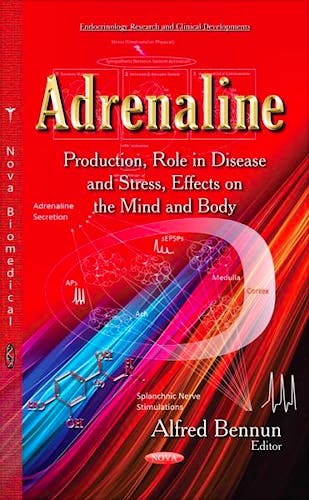

No hay productos en el carrito



Adrenaline. Production, Role in Disease and Stress, Effects on the Mind and Body
Bennun, A.
1ª Edición Agosto 2014
Inglés
Tapa dura
233 pags
502 gr
16 x 24 x 2 cm
ISBN 9781633210844
Editorial NOVA SCIENCE PUBLISHERS INC. U.S.
LIBRO IMPRESO
-5%
138,25 €131,34 €IVA incluido
132,93 €126,29 €IVA no incluido
Recíbelo en un plazo de
2 - 3 semanas
Description
The book examines the noradrenaline-emotional psyches (brain-blood barrier)
somatic-adrenaline axis. It conceptually updates research advances, diagnostic
techniques and therapeutic methods.
The authors enhance their discussions with clear illustrations and explicative
texts written for researchers, professionals, educators and students alike,
which favor its selection as an essential overview of recent medical and scientific
advances, allowing the reader to have the satisfaction of finding first-rate
accounts of important work.
Comparative studies between immediately obtained adrenal vein samples (AVS)
and 15 minutes thereafter show that the stress reactions induced by catheter
manipulation had an effect on serum cortisol and aldosterone values. A transient
increase in cortisol release from both adrenal glands occurs in the majority
of the patients who undergo AVS. This stress reaction can influence the assessment
of both the selectivity of the catheterization during the sequential AVS technique
and the lateralization of aldosteronoma bearing gland.
The separation of noradrenaline (NA) at brain and adrenaline at blood functions
as a homeostatic lame axis by the blood-brain barrier blocking adrenaline feedback
in hypothalamic-pituitary-adrenal (HTPA). This leads to postulate an evolution
adaptation for the brain dominance over body, which allows a psychoanalytic
treatment to function to signal turn-off and return to circadian homeostasis.
Decreased glucose could stress the HTPA axis and leads to decreasing metabolites
and releasing Mg2+ for integration of the brain-tissue network. Mg2+ changes
adenylyl cyclase (AC) from a Ca2+-AC complex to an Mg2+-AC form with responsiveness
to NA for short-term memory. The cAMP generated has been postulated for consolidation
of long-term memory.
Trigeminocardiac reflex evoked negative effects on hemodynamics which exaggerated
by use of beta-blockers and suggesting either a central control or efferent
pathways of TCR partly related to adrenergic responses.
Stress-induced cardiomyopathies such as Tako-Tsubo Syndrome primarily affect
post-menopausal women, more susceptible than the rest of the population, which
have experienced sudden emotional shock. The symptoms mimic a myocardial infarction
without a significant occlusion of the coronary arteries. Instead, they display
a left ventricular (LV) dysfunction called the “Apical-Ballooning Syndrome”.
Some of these patients show high circulating levels of adrenaline, and symptoms
respond to treatment with beta- adrenergic blockers.
Heart adrenoceptors are targets of elevated adrenaline during stress, mainly
subtype â1, but also: â2, á1, and â3. The first stage
of stress decrease the number of adrenoceptor binding sites but with prolonged
stress the number of receptors often returns to initial values. Stress can also
affect antagonistic muscarinic receptors. The regulation of G protein-coupled
receptors comprises desensitization, internalization or down-regulation of receptors.
The changes in total receptor number, degradation and gene expression taking
together impact heart fine-tuning and functional signaling.
Stress hormones cause structural transitions in erythrocyte membranes and increase
microviscosity in the regions of lipid-lipid and protein-lipid interactions.
And the perfusion of the isolated rat heart with the Krebs–Henseleit solution
containing erythrocytes preincubated with stress hormones sharply decreases
the coronary flow rate and rapidly stops it.
The study of adrenaline physiological effects, remain clinically important,
a general appreciation of adrenaline for emergency treatment and as an adjunct
to local anaesthesia is mandatory for any doctor in clinical practice, because
one day he may well use it to save someone’s life. (Imprint: Nova Biomedical)
Table of Contents
Chapter 1 - Adrenalines in Adrenal Venous Sampling (pp. 1-12)
Authors / Editors: (Yasutaka Baba, Sadao Hayashi, Shunichiro Ikeda and Masayuki
Nakajo, Department of Radiology, Graduate School of Medical and Dental Sciences,
Kagoshima University, Kagoshima, Japan)
Chapter 2 - NA-Overstimulation of the Hypothalamic-Pituitary Adrenal Axis Turns-On
the Fight-or Flight Response but Adrenaline Lacks a Negative Feedback which
Could Normalize Psychosomatic Dysfunctions (pp. 13-70)
Authors / Editors: (Alfred Bennun, Emeritus - Rutgers University, NJ, USA)
Chapter 3 - New Insights to the Role of (Nor-)/Adrenaline and Trigeminal Cardiac
Reflex (pp. 71-80)
Authors / Editors: (Tumul Chowdhury, Nora Sandu and Bernhard Schaller, Department
of Anesthesiology and Perioperative Medicine, Health Sciences Center, University
of Manitoba, Winnipeg, MB, Canada and others)
Chapter 4 - Adrenaline and Stress-Induced Cardiomyopathies: Three Competing
Hypotheses for Mechanism(s) of Action (pp. 81-116)
Authors / Editors: (Candice N. Baker, Rebekah Katsandris, Chaunhi Van and Steven
N. Ebert, Burnett School of Biomedical Sciences, College of Medicine, University
of Central Florida, Orlando, FL, USA)
Chapter 5 - Adrenaline, Heart Adrenoceptors and Stress (pp. 117-148)
Authors / Editors: (Jaromir Myslivecek, Paulina Valuskova and Eva Varejkova,
Institute of Physiology, 1st Faculty of Medicine, Charles University, Prague,
Czech Republic)
Chapter 6 - Influence of Stress Hormones (Adrenaline and Cortisol) on Structure
and Function of Erythrocyte Membranes (pp. 149-176)
Authors / Editors: (L.E. Panin, Scientific Research Institute of Biochemistry
SB RAMS, Novosibirsk, Russia)
Chapter 7 - Drugs in Cardiopulmonary Resuscitation (pp. 177-212)
Authors / Editors: (Isabel Teo, Kuen Yeow Chin, Christopher Stephens and James
Paget, Department of Plastic Surgery, Ninewells Hospital, Dundee, Scotland)
© 2025 Axón Librería S.L.
2.149.0